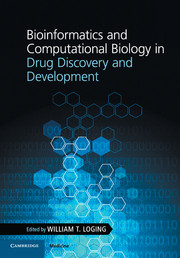Book contents
- Frontmatter
- Contents
- List of contributors
- Foreword: The future of drug discovery and healthcare
- Acknowledgments
- 1 The art and science of the drug discovery pipeline
- 2 Computational approaches to drug target identification
- 3 Understanding human disease knowledge through text mining
- 4 Integrating translational biomarkers into drug development
- 5 Computational phenotypic assessment of small molecules in drug discovery
- 6 Data visualization and the DDP process
- 7 Information visualization – important IT considerations
- 8 Example of computational biology at the new drug application (NDA) and regulatory approval stages
- 9 Clinical trial failures and drug repositioning
- Appendix I Additional knowledge-based analysis approaches
- Appendix II Open source tools and public data sources
- Index
- Plate section
- References
7 - Information visualization – important IT considerations
Published online by Cambridge University Press: 05 February 2016
- Frontmatter
- Contents
- List of contributors
- Foreword: The future of drug discovery and healthcare
- Acknowledgments
- 1 The art and science of the drug discovery pipeline
- 2 Computational approaches to drug target identification
- 3 Understanding human disease knowledge through text mining
- 4 Integrating translational biomarkers into drug development
- 5 Computational phenotypic assessment of small molecules in drug discovery
- 6 Data visualization and the DDP process
- 7 Information visualization – important IT considerations
- 8 Example of computational biology at the new drug application (NDA) and regulatory approval stages
- 9 Clinical trial failures and drug repositioning
- Appendix I Additional knowledge-based analysis approaches
- Appendix II Open source tools and public data sources
- Index
- Plate section
- References
Summary
Innovative approaches in drug discovery must be accompanied by innovative approaches in technology supporting those approaches, especially in the area of information visualization.
This chapter outlines the five fundamental components of computer-aided information visualization (CAIV). The components are: hardware components, interaction components, data visualization, application design, and user adaptation. These are not arbitrarily selected components, but rather an attempt to structure and assist with the effort in effectively implementing information visualization in an organization or department.
Additionally, this chapter will focus on the current and future state of each of the fundamental components that have been identified rather than its background. However, it is my hope that the topics will raise enough interest in the reader to further investigate and research the foundation of each component in its historical context to better understand their future.
Finally, this is an attempt to provide a novel and useful structure to assist a scientific or business organization with defining their implementation focus and effort, hoping that the readers will leave with a clear path on putting in place a proper approach to data mining and visualization in their academic or professional field, specifically in bringing more products to their final stages of development.
It is impossible to cover in detail in only one chapter the topics outlined above, but this chapter can be seen as a small introduction and reference guide to many other sources of information for the reader, so that they can start to understand and discover the potential and promise of CAIV for their organization and projects.
From data visualization to computer-aided information visualization
A distinction between data visualization as one of the components of CAIV is required to begin this chapter. Data visualization is in itself the core of CAIV where poor data representation design will undermine the whole analysis process. As Edward Tufte stated, “Graphical excellence consists of complex ideas communicated with clarity, precision, and efficiency” (Tufte, 2007). He adds, “Graphical excellence is that which gives to the viewer the greatest number of ideas in the shortest time with the least ink in the smallest space.”
It is here that CAIV enters and adds the remaining four components to facilitate the viewer to navigate, interact and react to the data presented.
- Type
- Chapter
- Information
- Publisher: Cambridge University PressPrint publication year: 2016



